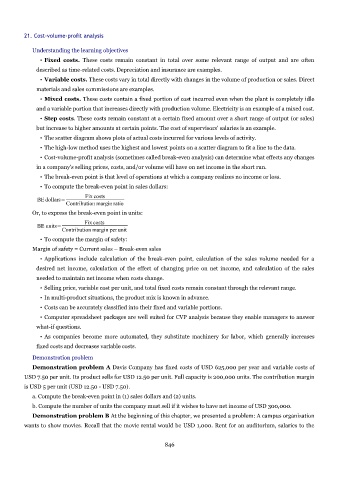Page 845 - Accounting Principles (A Business Perspective)
P. 845
21. Cost-volume-profit analysis
Understanding the learning objectives
• Fixed costs. These costs remain constant in total over some relevant range of output and are often
described as time-related costs. Depreciation and insurance are examples.
• Variable costs. These costs vary in total directly with changes in the volume of production or sales. Direct
materials and sales commissions are examples.
• Mixed costs. These costs contain a fixed portion of cost incurred even when the plant is completely idle
and a variable portion that increases directly with production volume. Electricity is an example of a mixed cost.
• Step costs. These costs remain constant at a certain fixed amount over a short range of output (or sales)
but increase to higher amounts at certain points. The cost of supervisors' salaries is an example.
• The scatter diagram shows plots of actual costs incurred for various levels of activity.
• The high-low method uses the highest and lowest points on a scatter diagram to fit a line to the data.
• Cost-volume-profit analysis (sometimes called break-even analysis) can determine what effects any changes
in a company's selling prices, costs, and/or volume will have on net income in the short run.
• The break-even point is that level of operations at which a company realizes no income or loss.
• To compute the break-even point in sales dollars:
Fix costs
BE dollars=
Contribution margin ratio
Or, to express the break-even point in units:
Fix costs
BE units=
Contribution margin perunit
• To compute the margin of safety:
Margin of safety = Current sales – Break-even sales
• Applications include calculation of the break-even point, calculation of the sales volume needed for a
desired net income, calculation of the effect of changing price on net income, and calculation of the sales
needed to maintain net income when costs change.
• Selling price, variable cost per unit, and total fixed costs remain constant through the relevant range.
• In multi-product situations, the product mix is known in advance.
• Costs can be accurately classified into their fixed and variable portions.
• Computer spreadsheet packages are well suited for CVP analysis because they enable managers to answer
what-if questions.
• As companies become more automated, they substitute machinery for labor, which generally increases
fixed costs and decreases variable costs.
Demonstration problem
Demonstration problem A Davis Company has fixed costs of USD 625,000 per year and variable costs of
USD 7.50 per unit. Its product sells for USD 12.50 per unit. Full capacity is 200,000 units. The contribution margin
is USD 5 per unit (USD 12.50 - USD 7.50).
a. Compute the break-even point in (1) sales dollars and (2) units.
b. Compute the number of units the company must sell if it wishes to have net income of USD 300,000.
Demonstration problem B At the beginning of this chapter, we presented a problem: A campus organization
wants to show movies. Recall that the movie rental would be USD 1,000. Rent for an auditorium, salaries to the
846

